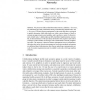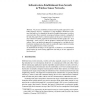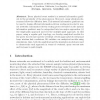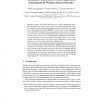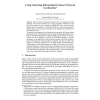110
click to vote
DCOSS
2005
Springer
15 years 6 months ago
2005
Springer
Abstract. Achieving optimal battery usage and prolonged network lifetime are two of the most fundamental issues in wireless sensor networks. By exploiting node and data redundancy ...
92
Voted
DCOSS
2005
Springer
15 years 6 months ago
2005
Springer
We present an efficient distributed data structure, called the D-SPANNER, for maintaining proximity information among communicating mobile nodes. The D-SPANNER is a kinetic sparse...
88
Voted
DCOSS
2005
Springer
15 years 6 months ago
2005
Springer
Abstract. We present a distributed, localized and integrated approach for establishing both low-level (i.e. exploration of 1-hop neighbors, interference avoidance) and high-level (...
DCOSS
2005
Springer
15 years 6 months ago
2005
Springer
Abstract. Every physical event results in a natural information gradient in the proximity of the phenomenon. Moreover, many physical phenomena follow the diffusion laws. This natu...
103
click to vote
DCOSS
2005
Springer
15 years 6 months ago
2005
Springer
Abstract: Since nodes in a sensor network have limited energy, prolonging the network lifetime and improving scalability become important. In this paper, we propose a distributed w...
69
Voted
DCOSS
2005
Springer
15 years 6 months ago
2005
Springer
A wide-area sensor system is a complex, dynamic, resource-rich cloud of Internet-connected sensing devices. In this paper, we propose X-Tree Programming, a novel database-centric ...
126
click to vote
DCOSS
2005
Springer
15 years 6 months ago
2005
Springer
Abstract. Wireless sensor networks can be very useful in applications that require the detection of crucial events, in physical environments subjected to critical conditions, and t...
102
Voted
DCOSS
2005
Springer
15 years 6 months ago
2005
Springer
Sensor network localization continues to be an important research challenge. The goal of localization is to assign geographic coordinates to each node in the sensor network. Locali...
126
Voted
DCOSS
2005
Springer
15 years 6 months ago
2005
Springer
In surveillance and tracking applications, wireless sensor nodes collectively monitor the existence of intruding targets. In this paper, we derive closed form results for predicti...
86
Voted
DCOSS
2005
Springer
15 years 6 months ago
2005
Springer
Abstract. Many sensor network applications demand tightly-bounded object detection quality. To meet such stringent requirements, we develop three sensing scheduling protocols to gu...

